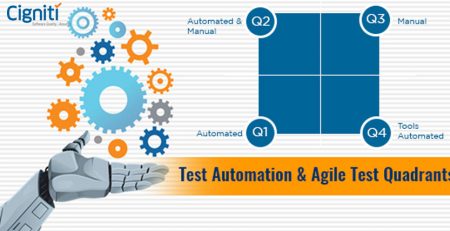What You Need to Know About Test Automation In Agile
Software development has transformed over time. Developers have gone from executing a project in the “waterfall” method to the “agile” method. Due to digitization of businesses, there is a necessity to leverage software development and remain technologically advanced. As part of the agile methodology, software testing is carried out throughout the application lifecycle. This means that the detection of bugs happens much earlier on in the process, thereby giving a much wider scope for immediate bug-fixes. However, when testing early, certain tests are repetitive in nature. Handling them manually requires a lot of time, and does not leave much scope for QA engineers to work much ahead in time. Test automation, hence, is key to quicker progress at a higher quality.
Why do We Need Test Automation in Agile?
[rule style=”rule-double-thick-thin” ]
In agile development, the emphasis is absolutely on building the right product and significantly reducing the overall risk associated with software development. Agile encourages and welcomes change, and to keep the change under control, the team has to invest in Test Automation. Moreover, investment in Continuous Integration is essential to shorten feedback cycles and to avoid having repetitive tasks executed by engineers.
A key principle of agile development is that testing is integrated and allows immediate and regular inspection of the working product that is being developed.
Agile QA team faces many challenges, a few of which have been mentioned below. Efficient test automation helps mitigate these challenges.
- Inadequate Test Coverage: Code changes that were not anticipated beforehand lead to Inadequate test coverage. Regression automation can ensure if the existing functionality is working as per requirement.
- Code Broken Accidentally due to Frequent Builds: Since the code being developed is changed and compiled daily, the likelihood of code (comprising of existing features) breaking, is much higher. To mitigate this issue, a proper automation suite ought to be designed with continuous integration.
- Inadequate API Testing: Most software is now designed with a service-orientated architecture that discloses their APIs openly, thereby encouraging third-party developers to extend the solution. When developing APIs, it can sometimes be easy to overlook API testing, due to the sheer complexity in implementing it. Testing APIs requires strong coding skills, which can be substituted using automation tools. This ensures that APIs are tested irrespective of the skillset of the tester.
- Performance Bottlenecks: As software delivers a more enhanced experience, the code gets more complex. This results in addition of even more lines of code and may result in performance issues if the end-user performance experience is not focused upon. To solve this issue, the first step is to identify areas of your code that are causing performance issues and how performance is being impacted over time. Load testing tools can help identify slow areas and can track performance over time, to more objectively document performance from release to release.
- Complicated Mobile testing: Manual mobile testing takes a lot of time to be executed, and with the number of devices growing in the market, so is the complexity of testing them. To ensure that the code does not break, there is a need for a strong automation suite for mobile to be executed with each build.
Automation tools and its approach should be decided based on the project requirement, as there can be different automation tools used either in unison or separately. There are different types of automation that can be used for validation like functional automation, Automated GUI, API testing automation, Mobile automation, or Performance testing.
Pros and Cons of Test Automation in Agile Development
[rule style=”rule-double-thick” ]
Advantages of Test automation in Agile Development:
As in any other software development model, the main advantages of automation are speed, reliability, comprehensiveness, programmability, and reusability. It’s no different for Agile as well; however, in Agile, the importance of automation is much higher than in any other software development models, because of the following reasons:
- Quick turnarounds: Unlike any other software development approach, Agile calls for quick turnarounds for QA. By implementing continuous integration in Agile, this can be solved.
- Repetitive execution: Agile calls for daily build deployments which can be certified using the right automation tool and a suitable automation approach.
- Quality assured: With a proper automation suite designed, the quality of the product can be assured at any given time by executing the automation suite. However, the test cases selected for automation need to have a good coverage of the application.
- Team is responsible for quality: Since automation is required in almost every phase of the agile process, the complete team is responsible for the quality of the product.
Disadvantages of Test automation in Agile Development:
- Agile tester skill set: Agile calls for QA to play multiple roles and have experience with automation tools, and at the same time have good functional knowledge which might be quite challenging to find in the market.
- Automation requires lot of planning: There is lot of planning required in selecting the right automation tool, deciding on the test approach, selecting the test cases to be automated.
- Developing automated functional tests is more challenging: Unlike in other software development models, in Agile, the UI is not available before starting automation. Most of the traditional functional automation tools depend on the object identification, which needs to be compromised. However, with good communication between the developer and QA, this can be overcome.
- Scope creep: There can be a lot of time spent on maintenance of the existing automation suite since Agile allows scope creep. This can be taken care of in the initial stages of automation development with proper planning.
- QA responsibility: With daily build validations for existing sprint and next sprint automation design, it becomes difficult for QA to manage both the sprints. This can be solved using two automation teams to work for existing sprint and new sprint.
Automation testing in different phases in Agile
[rule style=”rule-double-thick-thin” ]
Automation is carried on at different phases in agile development as mentioned below
- Automating Unit testing: Unit testing is still completed by developers as usual, but ideally there’s a much stronger emphasis on automated testing at the code unit level. This is to ensure that the code is validated at the unit level, which prevents from defects slippage.
- Automated tests before code is ready: In eXtreme Programming (XP), there is also a strong emphasis on test driven development, which is the practice of writing automated unit tests before writing code.
- System testing and integration testing: As there is at least a daily build, and ideally continuous integration, features can be tested as they are developed, in an integrated environment. The features are each tested as they are developed, one after the other, instead of at the end of the Sprint or iteration. Automation plays a vital role here and reduces the number of iterations for which existing features would need to undergo testing. This method makes sure that QA engineers do what they do best, and continue to lay emphasis on testing new features.
- Sprint complete: Towards the end of each sprint, when all features for the iteration have been completed, there needs to be time for a short regression test before releasing the software. Regression testing should be automated in a test driven development, with features tested continuously in an integrated environment.
Conclusion
Cigniti Technologies understands that test automation helps accelerate regression test efforts in a cost effective manner, and allows constantly unattended execution. Cigniti’s test automation framework (CTAF) is a tool agnostic testing solution for validating complex business processes. CTAF uses a keyword driven approach to help non-technical users validate business processes. CTAF has delivered 30% improvement in productivity and 40% reduction in test maintenance efforts in numerous test automation engagements.




Comment (1)
[…] post What You Need to Know About Test Automation In Agile appeared first on Software Testing Blog by Cigniti […]